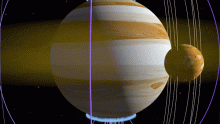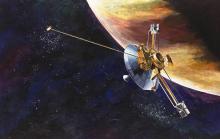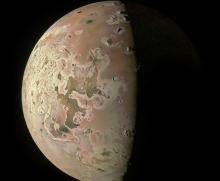Listen to today's episode of StarDate on the web the same day it airs in high-quality streaming audio without any extra ads or announcements. Choose a $8 one-month pass, or listen every day for a year for just $30.
You are here
Moon and Jupiter
Jupiter is the biggest, heaviest planet in the solar system. It’s about 11 times the diameter of Earth, and it’s more massive than all the other planets and moons combined.
Jupiter is also the fastest planet — it takes less than 10 hours to make one full turn on its axis. That means the clouds at its equator rotate at about 28,000 miles per hour, compared to one thousand miles per hour here on Earth.
Actually, the top of Jupiter’s atmosphere rotates at different rates. The clouds near the poles are a bit faster than those at the equator. But once you drop about 2,000 miles below the clouds, the rest of the planet all spins at about the same rate.
A recent study came up with a model to explain Jupiter’s high-speed rotation. It says that, as Jupiter formed, a strong magnetic field actually acted as a brake for a while. That slowed the planet down and kept it from spinning so fast that it flew apart.
After about 25,000 years, though, Jupiter began to speed up. It pulled in vast amounts of hydrogen and helium. As the material fell inward, it transferred momentum to the planet. Later, Jupiter’s own gravity caused the planet to shrink. Like a skater pulling in his arms, that sped up the rotation — just about matching what we see today.
And Jupiter is in great view tonight. The planet is quite close below or to the lower left of the crescent Moon as darkness falls — a giant world spinning through the solar system.
Script by Damond Benningfield






